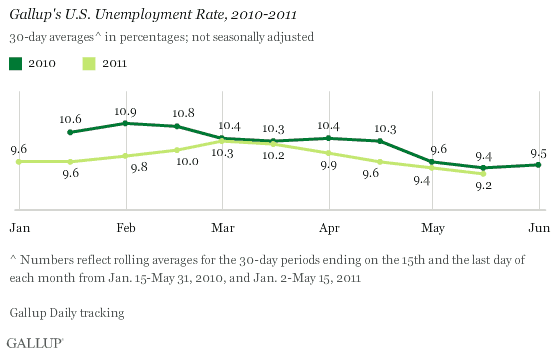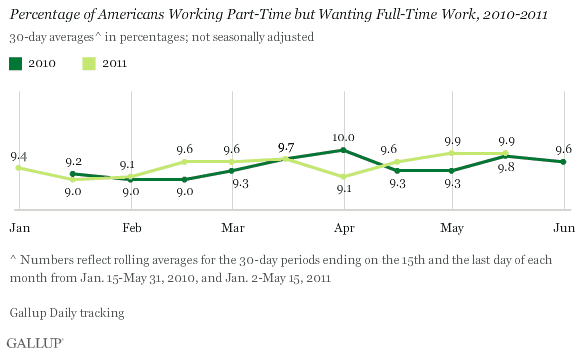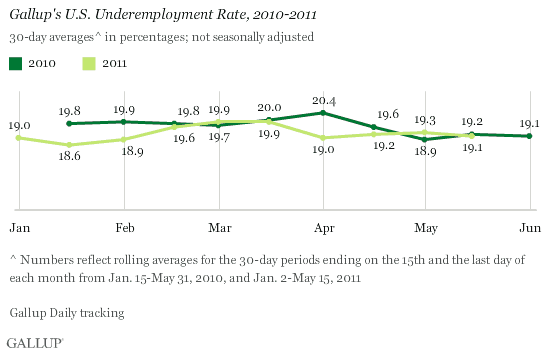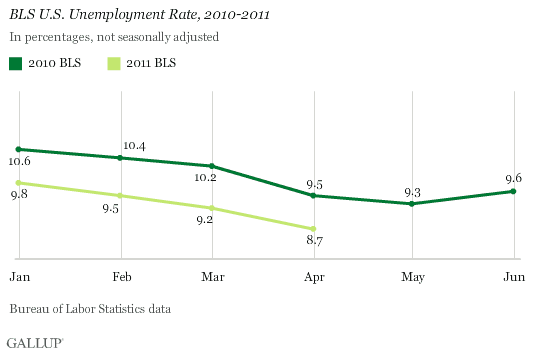PRINCETON, NJ -- Unemployment, as measured by Gallup without seasonal adjustment, is at 9.2% in mid-May -- down slightly from 9.4% at the end of April. It is also slightly lower than the 9.4% of mid-May last year.

The percentage of part-time workers who want full-time work is at 9.9% in mid-May -- the same as at the end of April. Just as many Americans are now working part time but seeking full-time work as was the case a year ago.

Underemployment Down Slightly, but Still High in Mid-May
Underemployment, a measure that combines the percentage of unemployed with the percentage working part time but wanting full-time work, was at 19.1% in mid-May -- down from 19.3% at the end of April. Underemployment remains as high as it was in mid-May 2010.

Government's U.S. Unemployment Rate Shows Year-Over-Year Decline
While Gallup's not seasonally adjusted U.S. unemployment rate suggests little improvement (0.2 percentage points) compared with the same time in 2010, the government's unadjusted results show a year-over-year decline of 0.8 points.
Interestingly, Gallup's monthly measures tracked closely to those the government reported in early 2010 but the two trends have diverged since January 2011.

The government's not seasonally adjusted unemployment rate is down from last year, even while its data show a total increase between 2010 and 2011 of about 360,000 in the number of Americans employed. This relatively small increase seems closer to what might be expected given Gallup's estimates of the year-over-year change in the unemployment rate as opposed to the government's.
Overall, it appears that much of the reason for the decline in the government's unemployment rate over the past year has to do with the approximately 1 million workers who left the workforce -- that is, they stopped looking for work -- between April 2010 and April 2011, and the government's re-benchmarking in January 2011. Gallup's data were not similarly affected by that re-benchmarking.
Implications
Gallup's U.S. unemployment data suggest little improvement in the jobs situation from mid-May 2010 to mid-May 2011. This contrasts sharply with the government's not seasonally adjusted unemployment data, which show about a one-point decline. As a result, the question arises as to whether there is significant underlying job growth taking place in the U.S.
More important than the year-over-year change in the U.S. jobs situation may be the lack of overall job growth during the first several months of 2011. Gallup data suggest that the improvement in the jobs situation from February of this year through mid-May could be largely due to seasonal hiring factors, given the similar unemployment patterns of 2010 and 2011. This seems consistent with government data showing a seasonally adjusted unemployment rate that began at 9.0% in January 2011, dipped in February and March, but ended up at 9.0% once again in April -- reflecting essentially no improvement in the jobs situation over the first four months of this year.
Interpreting the jobs situation is further complicated by other government data. The government reported that the private sector created 268,000 new jobs in April -- the highest number in five years, and consistent with Gallup's Job Creation Index. At the same time, jobless claims have been running at more than 400,000 during recent weeks -- a bad sign for future unemployment.
Regardless of how one interprets these mixed job market signals, however, it seems clear that there has not been anything resembling a significant job market improvement during the first half of 2011. And there has certainly not been enough improvement to alter Main Street Americans' perceptions of the overall jobs situation. This is likely one reason more than half of Americans continue to say the U.S. economy remains mired in recession or depression even as the nation's economists say the recession ended nearly two years ago.
Gallup.com reports results from these indexes in daily, weekly, and monthly averages and in Gallup.com stories. Complete trend data are always available to view and export in the following charts:
Daily: Employment, Economic Confidence and Job Creation, Consumer Spending
Weekly: Employment, Economic Confidence, Job Creation, Consumer Spending
Read more about Gallup's economic measures.
View our economic release schedule.
Survey Methods
Gallup classifies American workers as underemployed if they are either unemployed or working part time but wanting full-time work. The findings reflect more than 18,000 phone interviews with U.S. adults aged 18 and older in the workforce, collected over a 30-day period. Gallup's results are not seasonally adjusted and are ahead of government reports by approximately two weeks.
Results are based on telephone interviews conducted as part of Gallup Daily tracking from April 16-May 15, 2011, with a random sample of 18,703 adults, aged 18 and older, living in all 50 U.S. states and the District of Columbia, selected using random-digit-dial sampling.
For results based on the total sample of adults in the workforce, one can say with 95% confidence that the maximum margin of sampling error is ±1 percentage point.
Interviews are conducted with respondents on landline telephones and cellular phones, with interviews conducted in Spanish for respondents who are primarily Spanish-speaking. Each sample includes a minimum quota of 400 cell phone respondents and 600 landline respondents per 1,000 national adults, with additional minimum quotas among landline respondents for gender within region. Landline telephone numbers are chosen at random among listed telephone numbers. Cell phone numbers are selected using random-digit-dial methods. Landline respondents are chosen at random within each household on the basis of which member had the most recent birthday.
Samples are weighted by gender, age, race, Hispanic ethnicity, education, region, adults in the household, and phone status (cell phone only/landline only/both, cell phone mostly, and having an unlisted landline number). Demographic weighting targets are based on the March 2010 Current Population Survey figures for the aged 18 and older non-institutionalized population living in U.S. telephone households. All reported margins of sampling error include the computed design effects for weighting and sample design.
In addition to sampling error, question wording and practical difficulties in conducting surveys can introduce error or bias into the findings of public opinion polls.
For more details on Gallup's polling methodology, visit https://www.gallup.com/.
